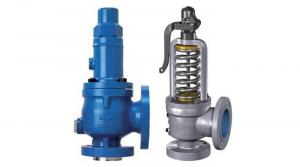Safety Valve Market Estimated to Grow at 8.01% CAGR, Reaching USD 14.35 Billion by 2032 | Danfoss, General Electric, IMI
Safety Valve Market grows with increasing industrial safety regulations and demand for pressure control in oil, gas, and power sectors.
Safety Valve Market An In-depth Analysis
The safety valve market plays a crucial role in a wide range of industrial applications by providing essential overpressure protection for equipment and systems. Safety valves are mechanical devices designed to open at a predetermined set pressure to prevent equipment failure and accidents caused by excessive pressure.
They are commonly used in industries such as oil & gas, power generation, chemicals, manufacturing, pharmaceuticals, and food & beverage. The global safety valve market has been experiencing consistent growth, fueled by the increasing demand for process safety in industrial operations and the adoption of stricter regulatory frameworks. As industries continue to evolve with the integration of smart technologies and automation, the demand for advanced safety valve solutions is expected to rise significantly.
Get Free Sample PDF Brochure: https://www.marketresearchfuture.com/sample_request/7790
Key Companies in the safety valve market include
Emerson Electric Co (US)
Schlumberger Limited (US)
General Electric (US)
Curtiss-wright Corporation (US)
ALFA LAVAL (Sweden)
IMI plc (UK)
LESER GmbH & Co.KG (Germany)
The Weir Group PLC (Scotland)
Forbes Marshall (India)
Danfoss (Denmark)
Bosch Rexroth AG (Germany)
Spirax Sarco Limited (UK)
Market Trends Highlights
Several key trends are currently shaping the safety valve market. One of the most prominent trends is the integration of smart safety valves equipped with sensors and real-time monitoring systems. These smart valves enable predictive maintenance, remote operation, and enhanced system diagnostics, contributing to operational efficiency and safety compliance. Another notable trend is the rising demand for customized safety valves, driven by the need for industry-specific applications and environmental conditions. Furthermore, the shift toward green energy and sustainable practices is influencing the market, with increased deployment of safety valves in renewable energy sectors such as geothermal and hydrogen plants.
Additive manufacturing (3D printing) is also making inroads in safety valve production, enabling more complex and lightweight designs while reducing lead times and manufacturing costs. Additionally, the growing emphasis on environmental health and safety (EHS) regulations, especially in developed regions such as North America and Europe, is compelling industries to upgrade or replace outdated safety systems with modern and compliant safety valves.
Market Dynamics
The dynamics of the safety valve market are shaped by a combination of technological advancements, regulatory compliance requirements, competitive landscape, and end-user demand. The industry is moderately fragmented, with several key players competing on the basis of product innovation, reliability, and service offerings. Some of the leading companies in the market include Emerson Electric Co., Weir Group PLC, Baker Hughes Company, IMI PLC, and LESER GmbH & Co. KG.
Regulatory bodies such as the American Society of Mechanical Engineers (ASME), Occupational Safety and Health Administration (OSHA), and European Pressure Equipment Directive (PED) mandate rigorous standards for pressure relief equipment, pushing manufacturers to invest in R&D and quality assurance. This regulatory push acts both as a catalyst and a constraint—while it spurs innovation and safety, it also raises the cost of compliance and product development.
Buy Now Premium Research Report: https://www.marketresearchfuture.com/checkout?currency=one_user-USD&report_id=7790
Market Drivers
Several factors are driving the growth of the safety valve market. First and foremost is the increasing industrialization and infrastructure development, especially in emerging economies such as India, China, Brazil, and Southeast Asian countries. These nations are witnessing rapid expansion of manufacturing, energy, and transportation sectors—all of which require robust safety mechanisms.
Secondly, the stringent regulatory and safety norms imposed by governments and international organizations are compelling industries to adopt high-performance safety valves. With growing awareness of workplace safety and the potential costs of equipment failure or accidents, there is an increasing inclination towards preventive safety systems.
Another major driver is the expansion of oil & gas exploration and production activities, particularly in offshore and deep-sea projects, which demand high-quality and durable safety valves capable of withstanding extreme pressure and corrosive environments. Similarly, the growth of the chemical and pharmaceutical sectors, where precise pressure control is critical, is also contributing to the rising demand for advanced safety valves.
Market Restraints
Despite the positive outlook, the safety valve market faces several challenges. One of the primary restraints is the high cost of advanced safety valves, particularly those integrated with digital and smart technologies. This may deter small and medium-sized enterprises (SMEs) from upgrading their safety systems, especially in cost-sensitive markets.
Another significant challenge is the complexity of installation and maintenance, which requires skilled technicians and regular inspections to ensure optimal performance. This can add to operational costs and create barriers in regions with limited technical expertise.
Additionally, variability in global standards and certification requirements can hinder international trade and expansion for manufacturers. The lack of harmonization between different regional safety regulations complicates product development and market entry strategies for global players.
Market Segmentation Description
The safety valve market can be segmented based on material type, size, end-user industry, pressure rating, and geography.
By Material Type: Safety valves are commonly made from materials such as stainless steel, cast iron, carbon steel, and others. Stainless steel valves are preferred in industries with high hygiene standards and corrosive environments, like pharmaceuticals and food processing.
By Size: Valves range from small-size valves for precise pressure control in lab settings to large-size valves used in pipelines and heavy machinery.
By End-User Industry: Key end-use sectors include oil & gas, power generation, chemicals, food & beverage, pharmaceuticals, water treatment, and manufacturing. Among these, the oil & gas segment holds a substantial share due to the critical need for pressure safety in exploration, refining, and distribution.
By Pressure Rating: Safety valves are categorized into low, medium, and high-pressure applications, depending on their operational range.
Browse In-depth Market Research Report: https://www.marketresearchfuture.com/reports/safety-valve-market-7790
Future Trends
Looking ahead, the safety valve market is poised for sustained growth, with several emerging trends likely to shape its trajectory. The adoption of Industry 4.0 and the rise of industrial IoT (IIoT) will continue to push the integration of smart features in safety valves, such as real-time diagnostics, wireless communication, and automatic alerts for maintenance needs.
The transition towards hydrogen energy and carbon capture projects will open new application areas for safety valves, requiring materials and designs capable of handling novel challenges. As sustainability becomes a core business objective, environmentally friendly and recyclable valve materials will gain preference.
Furthermore, collaborative innovation between manufacturers and digital solution providers is expected to give rise to integrated safety management platforms that monitor entire systems, rather than individual components. The use of augmented reality (AR) and virtual reality (VR) for training and maintenance of safety systems may also become mainstream.
More Related Reports:
Reels And Spools Market: https://www.marketresearchfuture.com/reports/reels-spools-market-23575
Reflective Tape Market : https://www.marketresearchfuture.com/reports/reflective-tape-market-23581
Road Stud And Delineator Market: https://www.marketresearchfuture.com/reports/road-stud-delineator-market-23486
Rotary Indexer Market: https://www.marketresearchfuture.com/reports/rotary-indexer-market-23495
Sand Blasting Machine Market : https://www.marketresearchfuture.com/reports/sand-blasting-machine-market-23508
Screening Equipment Market: https://www.marketresearchfuture.com/reports/screening-equipment-market-23522
Screw Jacks Market: https://www.marketresearchfuture.com/reports/screw-jacks-market-23536
Levin & Perconti Secures $4.975M Settlement for Septic Shock That Lead to Patient's Death
Trident Wealth Partners Expands National Reach with Virtual Financial Advisory Services
Metro Building and Remodeling Group Rebrands as Metro Design Build Group
Kalendarium
Więcej ważnych informacji
 Jedynka Newserii
Jedynka Newserii

 Jedynka Newserii
Jedynka Newserii

Prawo

KE proponuje nowy Fundusz Konkurencyjności. Ma pobudzić inwestycje w strategiczne dla Europy technologie
W środę 16 lipca Komisja Europejska przedstawiła projekt budżetu na lata 2028–2034. Jedna z propozycji zakłada utworzenie Europejskiego Funduszu Konkurencyjności o wartości ponad 400 mld euro, który ma pobudzić inwestycje w technologie strategiczne dla jednolitego rynku. Wśród wspieranych obszarów znalazła się obronność i przestrzeń kosmiczna. Na ten cel ma trafić ponad 130 mld euro, pięciokrotnie więcej niż do tej pory.
Firma
Były prezes PGE: OZE potrzebuje wsparcia magazynów energii. To temat traktowany po macoszemu

Choć udział odnawialnych źródeł energii w miksie energetycznym Polski jest stosunkowo wysoki i rośnie, to ten przyrost jest chaotyczny i nierównomiernie rozłożony miedzy technologiami – wskazuje Forum Energii. Dodatkowo OZE potrzebują wsparcia magazynów energii, a zdaniem Wojciecha Dąbrowskiego, prezesa Fundacji SET, ten temat jest traktowany po macoszemu. Brak magazynów powoduje, że produkcja energii z OZE jest tymczasowo wyłączana, co oznacza marnowanie potencjału tych źródeł.
Infrastruktura
Wzrost wynagrodzeń ekip budowlanych najmocniej wpływa na koszty budowy domu. Zainteresowanie inwestorów mimo to nieznacznie wzrasta

Budowa metra kwadratowego domu w Polsce kosztuje od 5,55 do 6 tys. zł w zależności od województwa – wynika z najnowszych analiz firmy Sekocenbud. Najdrożej jest w Warszawie, gdzie cena za metr kwadratowy domu przekroczyła już 6,2 tys. zł. Na przyrosty kosztów budowy domu wpływają zarówno drożejące materiały budowlane, jak i wyższe wynagrodzenia pracowników. Inwestorzy nie rezygnują jednak z budowy domów jednorodzinnych, co ma związek m.in. z wciąż wysokimi cenami mieszkań czy też obniżką stóp procentowych.
Partner serwisu
Szkolenia

Akademia Newserii
Akademia Newserii to projekt, w ramach którego najlepsi polscy dziennikarze biznesowi, giełdowi oraz lifestylowi, a także szkoleniowcy z wieloletnim doświadczeniem dzielą się swoją wiedzą nt. pracy z mediami.









.gif)

 |
| |
| |
|